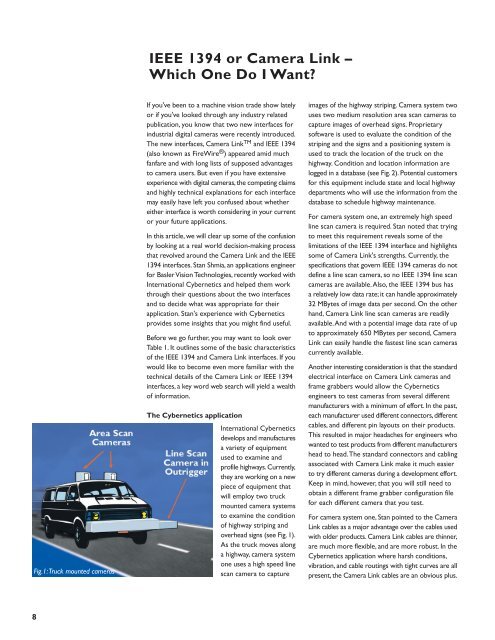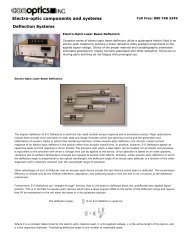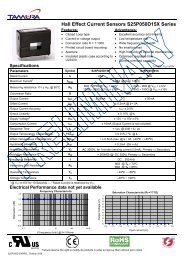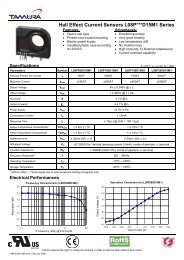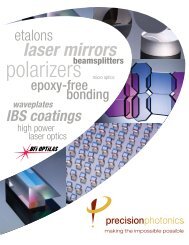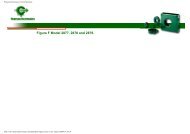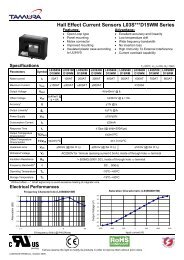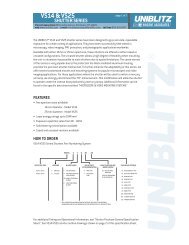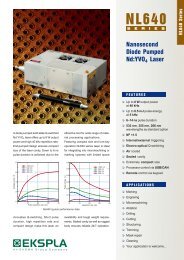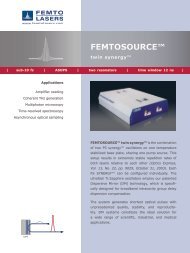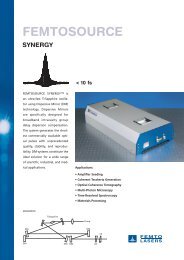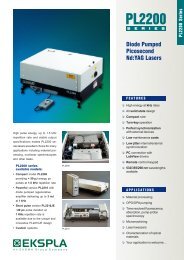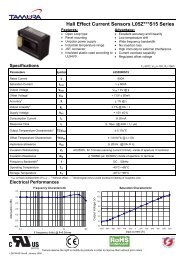Basler L301kc - BFi OPTiLAS
Basler L301kc - BFi OPTiLAS
Basler L301kc - BFi OPTiLAS
- TAGS
- basler
- optilas
- bfioptilas.com
You also want an ePaper? Increase the reach of your titles
YUMPU automatically turns print PDFs into web optimized ePapers that Google loves.
8<br />
IEEE 1394 or Camera Link –<br />
Which One Do I Want?<br />
If you've been to a machine vision trade show lately<br />
or if you've looked through any industry related<br />
publication, you know that two new interfaces for<br />
industrial digital cameras were recently introduced.<br />
The new interfaces, Camera Link TM and IEEE 1394<br />
(also known as FireWire ® ) appeared amid much<br />
fanfare and with long lists of supposed advantages<br />
to camera users. But even if you have extensive<br />
experience with digital cameras, the competing claims<br />
and highly technical explanations for each interface<br />
may easily have left you confused about whether<br />
either interface is worth considering in your current<br />
or your future applications.<br />
In this article, we will clear up some of the confusion<br />
by looking at a real world decision-making process<br />
that revolved around the Camera Link and the IEEE<br />
1394 interfaces. Stan Shmia, an applications engineer<br />
for <strong>Basler</strong> Vision Technologies, recently worked with<br />
International Cybernetics and helped them work<br />
through their questions about the two interfaces<br />
and to decide what was appropriate for their<br />
application. Stan's experience with Cybernetics<br />
provides some insights that you might find useful.<br />
Before we go further, you may want to look over<br />
Table 1. It outlines some of the basic characteristics<br />
of the IEEE 1394 and Camera Link interfaces. If you<br />
would like to become even more familiar with the<br />
technical details of the Camera Link or IEEE 1394<br />
interfaces, a key word web search will yield a wealth<br />
of information.<br />
The Cybernetics application<br />
International Cybernetics<br />
develops and manufactures<br />
a variety of equipment<br />
used to examine and<br />
profile highways. Currently,<br />
they are working on a new<br />
piece of equipment that<br />
will employ two truck<br />
mounted camera systems<br />
to examine the condition<br />
of highway striping and<br />
overhead signs (see Fig. 1).<br />
As the truck moves along<br />
a highway, camera system<br />
one uses a high speed line<br />
scan camera to capture<br />
images of the highway striping. Camera system two<br />
uses two medium resolution area scan cameras to<br />
capture images of overhead signs. Proprietary<br />
software is used to evaluate the condition of the<br />
striping and the signs and a positioning system is<br />
used to track the location of the truck on the<br />
highway. Condition and location information are<br />
logged in a database (see Fig. 2). Potential customers<br />
for this equipment include state and local highway<br />
departments who will use the information from the<br />
database to schedule highway maintenance.<br />
For camera system one, an extremely high speed<br />
line scan camera is required. Stan noted that trying<br />
to meet this requirement reveals some of the<br />
limitations of the IEEE 1394 interface and highlights<br />
some of Camera Link's strengths. Currently, the<br />
specifications that govern IEEE 1394 cameras do not<br />
define a line scan camera, so no IEEE 1394 line scan<br />
cameras are available. Also, the IEEE 1394 bus has<br />
a relatively low data rate; it can handle approximately<br />
32 MBytes of image data per second. On the other<br />
hand, Camera Link line scan cameras are readily<br />
available. And with a potential image data rate of up<br />
to approximately 650 MBytes per second, Camera<br />
Link can easily handle the fastest line scan cameras<br />
currently available.<br />
Another interesting consideration is that the standard<br />
electrical interface on Camera Link cameras and<br />
frame grabbers would allow the Cybernetics<br />
engineers to test cameras from several different<br />
manufacturers with a minimum of effort. In the past,<br />
each manufacturer used different connectors, different<br />
cables, and different pin layouts on their products.<br />
This resulted in major headaches for engineers who<br />
wanted to test products from different manufacturers<br />
head to head. The standard connectors and cabling<br />
associated with Camera Link make it much easier<br />
to try different cameras during a development effort.<br />
Keep in mind, however, that you will still need to<br />
obtain a different frame grabber configuration file<br />
for each different camera that you test.<br />
For camera system one, Stan pointed to the Camera<br />
Link cables as a major advantage over the cables used<br />
with older products. Camera Link cables are thinner,<br />
are much more flexible, and are more robust. In the<br />
Cybernetics application where harsh conditions,<br />
vibration, and cable routings with tight curves are all<br />
present, the Camera Link cables are an obvious plus.


